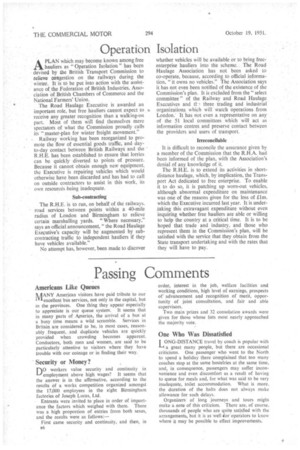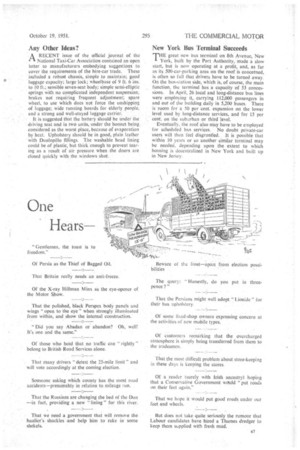Passing Comments
Page 40

Page 41

If you've noticed an error in this article please click here to report it so we can fix it.
Americans Like Queues
NAANY American visitors have paid tribute to our I excellent bus services, not only in the capital, but in the provinces. One thing they appear especially to appreciate is our queue system. It seems that in many parts of America, the arrival of a bus at a busy time means a wild scramble. Services in Britain are considered to be, in most cases, reasonably frequent, and duplicate vehicles are quickly provided when crowding becomes apparent. Conductors, both men and women, are said to be particularly attentive to visitors where they have trouble with our coinage or in finding their way.
Security or Money?
JO workers value security and continuity in .-F employment above high wages? It seems that the answer is in the affirmative, according to the results of a works competition organized amongst the 17,040 employees in the eight Birmingham factories of Joseph Lucas, Ltd. Entrants were invited to place in order of importance the factors which weighed with them. There was a high proportion of entries from both sexes, and the results were as follows:— First came security and continuity, and then, in B6
order, interest in the job, welfare facilities and working conditions, high level of earnings, prospects of advancement and recognition of merit, opportunity of joint consultation, and fair and able supervisors. Two main prizes and 32 consolation awards were given for those whose lists most nearly approached the majority vote.
One Who Was Dissatisfied
LONG-DISTANCE travel by coach is popular with L-4, a great many people, but there are occasional criticisms. One passenger who went to the North to spend a holiday there complained that too many coaches stop at the same hostelries at the same time, and, in consequence, passengers may suffer inconvenience and even discomfort as a result of having to queue for meals and, for what was said to be very inadequate, toilet accommodation. What is more, the duration of the halts does not always make allowance for such delays. Organizers of long journeys and tours might make a note of this criticism. There are, of course, thousands of people who are quite satisfied with the arrangements, but it is as well .for'operators to know where it may be possible to effect improvements.
Any Other Ideas?
A RECENT issue of the official journal of the r-1 National Taxi-Car Association contained an open letter to manufacturers embodying suggestions to cover the requirements of the hire-ear trade. These included a robust chassis, simple to maintain; good luggage capacity; large lock; wheelbase of 9 ft. 6 Ins. to 10 ft.; sensible seven-seat body; simple semi-elliptic springs with no complicated independent suspension; brakes not requiring frequent adjustment; spare wheel, to use which does not force the unshipping of luggage; wide running boards for elderly people, and a strong and well-stayed luggage carrier.
It is suggested that the battery should be under the driving seat and in two units, under, the bonnet being considered as the worst place, because of evaporation by heat. Upholstery should be in good, plain leather with Dunlopillo fillings. The washable head lining could be of plastic, but thick enough to prevent tearing as a result of air pressure when the doors are closed quickly with the windows shut.
New York Bus Terminal Succeeds
T" great new bus terminal On 8th Avenue, New
York, built by the Port Authority, made a slow start, but is now operating at a profit, and, as far as its 500-car-parking area on the roof is conceined, is often so full that drivers have to be turned away. On the bus-siation side, which is, of course, the main function, the terminal has a capacity of 53 concessions. In April, 26 local and long-distance bus lines were employing it, carrying 112,000 passengers in and out of the building daily in 5,200 buses. There is room for a 50 per Cent. expansion on the lower level used by long-distance services, and for 15 per cent, on the suburban or thircrlevel.
Eventually, the roof. also May have to be employed for scheduled bus services. No doubt private-car users will then feel disgruntled... It is possible that within 10 years or so another similar terminal may be needed, depending upon the extent to which housing is decentralized in New York and built up in New Jersey:




































































































